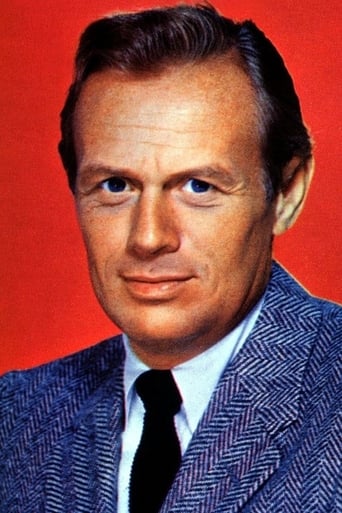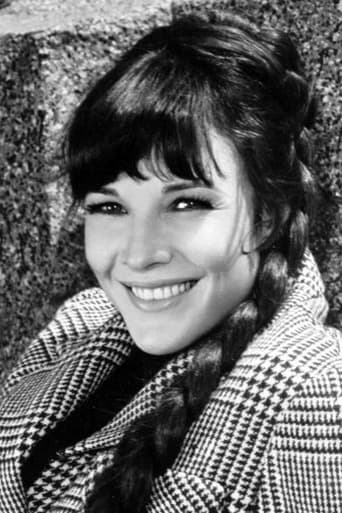Lovesusti
The Worst Film Ever
Pluskylang
Great Film overall
Odelecol
Pretty good movie overall. First half was nothing special but it got better as it went along.
Spikeopath
Alvarez Kelly is directed by Edward Dmytryk and stars William Holden & Richard Widmark. It's written by Elliott Arnold & Franklin Coen (Dan Taradash uncredited for tidying it up), the locations for the shoot are Baton Rouge & Clinton, Louisiana, with Joseph MacDonald on photography (Panavision). Story is apparently based on a true US Civil War incident in 1864, it sees Alvarez Kelly (Holden) kidnapped by Confederate's led by Tom Rossiter (Widmark) and forced to drive a herd of Union owned cattle to the hungry Reb troops in Richmond.Slow moving and blighted by a tepid script, Alvarez Kelly relies on its stars and photography to keep it out the trough. Evidently the makers were going for a social conscious piece based around an historical incident. All that is achieved is an overly talky piece, with periods of inane conversations; that is only briefly lit up by its action packed finale. And even then it can be argued that the "battle for the bridge" and the subsequent "stampede" isn't worth waiting 90 minutes for. The acting is solid, where Holden plays a role he could do in his sleep, and Widmark, sporting an eye patch, convinces as a rough and ready Colonel. Most pleasing is MacDonald's photography, not just for capturing the essence of the barren South in Baton Rouge, but also his choice of lenses for the top notch costuming (take a bow Seth Banks) afforded the ladies of the piece (Janice Rule & Victoria Shaw). There's a lovely print for this film, where in High Definition the colours positively ping from the screen.Dmytryk (Broken Lance/Warlock), Holden (The Horse Soldiers/The Wild Bunch) & Widmark (The Last Wagon/Cheyenne Autumn) owe Western fans nothing, but this is one from the three guys that's easily forgotten once the end credit rolls. 5/10
MARIO GAUCI
This is another film I decided to re-acquaint myself with in order to pay a well-deserved tribute to the late, great Richard Widmark. It’s one of the last Westerns he did and, in fact, it came at a time when the old-style Hollywood approach to the genre was coming to an end; actually, Widmark’s co-star from ALVAREZ KELLY – William Holden (here playing the title character) – would only a few years later feature in the film that gave the Western new-fangled maturity and an equally potent elegiac tone i.e. Sam Peckinpah’s THE WILD BUNCH (1969)! Anyway, to get back to the matter at hand, ALVAREZ KELLY seems to me to be unjustly neglected when it comes to discussing large-scale Westerns of the era. It may be because there is little action per se – though the climactic skirmish/chase (culminating in the blowing-up of a bridge: let’s not forget that Holden was one of the leads in two big-budget, star-studded war adventures, namely THE BRIDGES AT TOKO-RI [1954] and THE BRIDGE ON THE RIVER KWAI [1957]) is exciting enough – or the fact that the plot is atypical (inspired by a true incident in which a herd of cattle, sold to the Yanks by neutral Holden during the American Civil War, is stolen en masse from under their very noses by the opposing Confederate side, led by Widmark and who has abducted Holden to this end!). With respect to this curious narrative, the film opens with a nice animated sequence depicting the importance of securing food at a time of war throughout the ages.The two stars’ respective parts have been tailor-made for their established screen personas. Holden is cynical, opportunistic and charming (ironically, I’ve just recalled that I used these exact same words to describe Widmark’s younger character in GARDEN OF EVIL [1954]!). Widmark, on the other hand, is here a tough army man whose commitment to the Southern cause makes him ruthless above all else – alienating him from fiancée Janice Rule, and even considering drowning the entire herd in a swamp if it’s to fall back into the hands of the Yanks; sensing his unreasonable outlook early on, Holden quips: “God save me from dedicated men”! They’re at their best in a couple of major confrontation scenes: the first in which a one-eyed Widmark shoots off one of Holden’s fingers (while the latter is in prison) because of his lack of co-operation, and when Holden coolly explains to an aghast – and subsequently furious – Widmark that the clandestine passage he arranged for (on a steamboat which has just sailed) was not for himself but rather the disenchanted Rule! Predictably, but believably, the two men’s relationship ends in mutual respect – with Widmark even saving Holden’s life towards the end.The supporting cast is led by the afore-mentioned Rule, who does quite well by her Southern belle role (another lady – played by Victoria Shaw – proves more responsive and loyal to Widmark’s exploits), and Patrick O’Neal in the part of the Unionist Major who negotiated the initial deal with Holden, is having a hard time convincing his superiors of the enemy’s incredible plan, and who can’t fathom how the black slaves are unwilling to emancipate themselves (but rather shield those who want to keep them under their thumb!). By the way, surely one of the film’s main assets is John Green’s cheerful and memorable score (complete with a hackneyed yet agreeable title tune sung by The Brothers Four, an obscure folk group which seems to have remained active to this day).This unusual Western, then, is more than just a pleasant diversion (an epithet by which it’s often dismissed): good-looking, engaging, and certainly never boring – despite a not inconsiderable length of 110 minutes (though it’s listed officially on most sources at my disposal as being 116!).
rhp6033
In the early 1960's, there was quite a bit of interest in the Civil War during the centennial observances of events over the four-year period. Quite a few films were released either about the war, or which had the war in the background or as preludes to western films, which were very popular at the time. This film fits within that genre - both as a "civil war" film, which is also a bit of a "western", considering the cattle-rustling angle.This movie is (loosly) based upon an actual event. In September of 1964, Lee's Army of Northern Virginia was besieged by Grant's forces in entrenchments which stretched along the eastern side of Richmond, then south across the James river, then along the southern border of Petersburg, Virginia. A confederate scout noticed a large heard of cattle (approaching 4000 head) located at Coggins Point on the James River, not far from Grant's headquarters. In the army parlance of the days before refrigeration or canning to preserve meat, this was referred to by the commissary services as "beef on the hoof".Confederate Lt. Gen. Wade Hampton organized a raid which swung wide around the Union lines, traveled through Union-held territory to the site, overcame the small guard, and herded 2,468 cattle back into the Confederate lines where it became a welcome addition to the scanty rations the Confederate troops normally received. The Confederate losses were quite small - 10 killed, 47 wounded, and 4 missing, according to Hampton's official after-action report.The raid went down in history as either "Hampton's Cattle Raid", or simply "The Great Beefsteak Raid".Of course, the lead character "Alverez Kelly" from the movie has no real counterpart in history of which I am aware.
harryelsucio1212
I have just watched this movie on Spain's Canal Sur, in Spanish, which probably did not make much difference, as the Spaniards are wizards at dubbing, and the main character in any case is an Irish-Mexican. In addition, I avoided by this means Widmark's Southern drawl, said by those better qualified to judge than myself to be hilariously bogus. When I have seen him in films with English dialogue including Westerns, he has always sounded very urban to me, probably hailing from some part of New York and I have never noticed that he has attempted to change his accent before. So this was probably an isolated attempt that didn't work out. He is, nonetheless, an excellent actor, and we must recall that even our late great Sir John Gielgud made a terrible hash of this too, on the very rare occasions he was induced to speak with a different accent from his plum-in-the mouth, silver tones.If you are looking for a Western of the inferior spaghetti type (I do not include Sergio Leone in that description), with non-stop violence and a corpse a minute, be sure to give this one a miss! Although a war film, its mood for the greater part of the footage is great calm, but a calm fraught with tensions. It takes at least three quarters of an hour for the first death to occur (unless there was a fatality at the Alvarez hacienda in the first few seconds, which I happened to miss, and that is unlikely). And immediately after this fatality, a party of Blues capture a party of Greys, who with hardly a pause turn the tables on the former, but without causing any further losses to either side or even anybody getting wounded. The development of the plot is mainly without physical action, so that I must admit it does tend to drag at times. The main protagonists quietly and stealthily pitch their wits against each other: that is why the incident of the severed finger(already mentioned on the general introduction page) comes as such a brutal shock. But the true nature of war, including the American Civil War, is like that: much manoeuvring (Am. maneuvering) without very much happening for most of the time, interrupted by sporadic, sudden flare-ups.The main characters are well-drawn with many quirks and foibles and there is much humour in their interaction and the awkward situations they find themselves in. A good example of this is the frustration of Widmark, the one-eyed Confederate colonel, who with the reluctant help of the devious civilian,but pro tem acting colonel, Holden, tries to turn the dude grey-coated soldiers into competent cow-hands. Both Widmark and Holden take turns in being the butt of the various ironies, but the stiff-necked, self-opiniated and bumbling Union major played by O'Neill, is the object of such ironies for most of his on-screen time, including from his commanding officer.The photography is good, the scenery (supposed to be Virginian although the film was said to be shot in Louisiana) is very beautiful, and the costumery and indoor décor quite colourful and well-researched. The women,however, are rather insipid, especially when compared to those belles in a similar situation in the Wayne-Holden opus "The Horse Soldiers", not to mention the vivacious Vivienne Leigh in "Gone with the Wind", though that is an unfair comparison. Not a movie,then, for those Western fans who like fast action. But, if you are patient enough, there is a terrific finale with a battle, which (to avoid giving too much away), is very reminiscent of a scene from "How the West was Won" which also involved Richard Widmark and, now I come to think of it, also of a sequence in "The Wild Bunch", starring Holden.Although I had already been around for some time when this film first came out, I had hitherto never seen it or even heard of it, despite the fact that I am quite fond of good Westerns, a fan of both the main actors, and have have often been impressed by O'Neill too. I can only imagine that this occurred because it proved a commercial flop, by reason of the faults above-mentioned, and was shelved. It had never been shown before on the channel where I saw it, and there is little that they do not repeat again and again and again.





